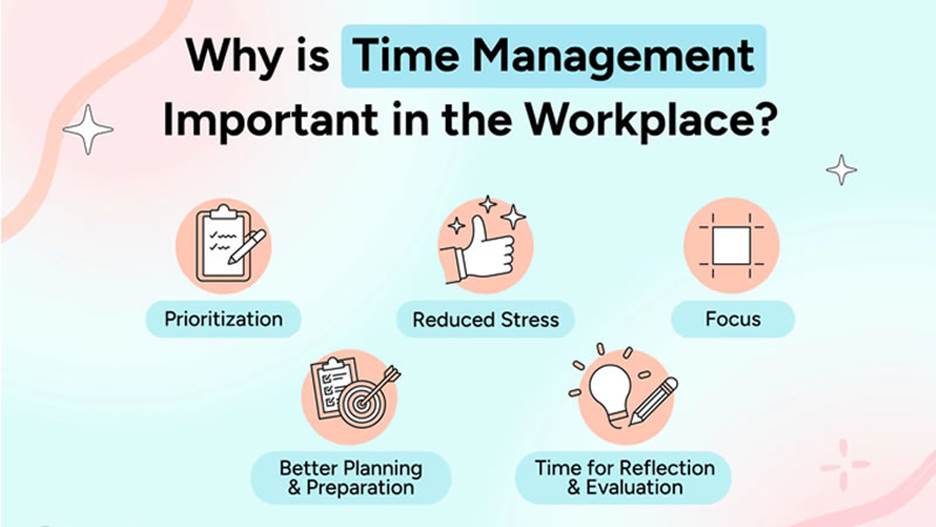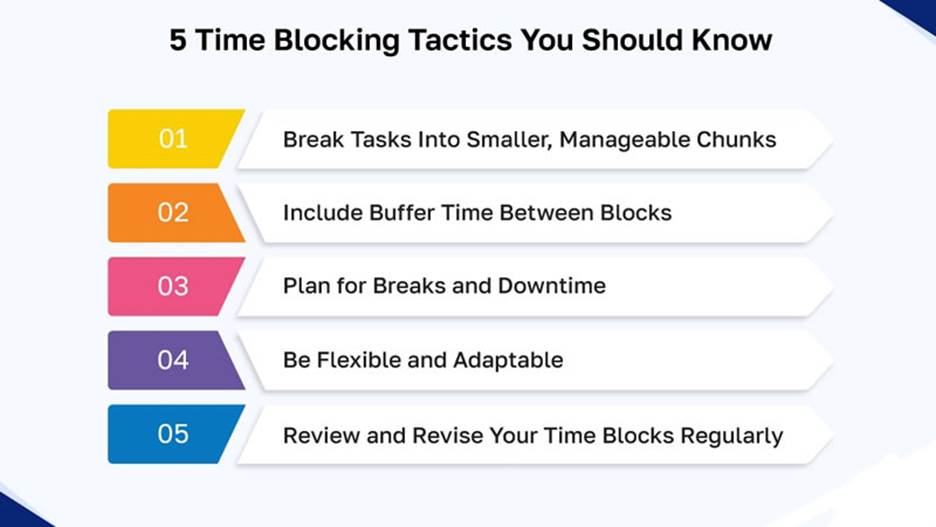Managing time well is one of the most important skills you can develop, whether you’re a student, professional, entrepreneur, or homemaker. Each of us gets the same 24 hours every day, yet some people accomplish more in a single morning than others do in an entire day. The difference isn’t luck; it’s the ability to organize tasks and apply smart time management tips.
In this article, we’ll explore how to structure your day for maximum efficiency, avoid common productivity pitfalls, and apply practical productivity hacks that will help you stay on track. By the end, you’ll have a clear framework to organize your time better and get more done without burning out.

Why Time Management Matters
Time is the one resource you can’t get back. Once a minute passes, it’s gone forever. That’s why learning effective time management is more than just a skill; it’s a necessity. Poor time management can lead to stress, missed deadlines, low-quality work, and even health issues due to a lack of balance. On the other hand, applying time management tips consistently helps you:
- Increase productivity without overworking.
- Create room for both professional goals and personal life.
- Reduce stress by eliminating last-minute rushes.
- Improve focus and decision-making.
When you start treating your time with as much value as money, you’ll notice a major shift in your daily results.
Step 1: Set Clear Priorities
A well-organized day starts with knowing what’s important. Many people confuse being busy with being productive, but they’re not the same. Checking emails for three hours might keep you occupied, but it doesn’t necessarily bring you closer to your goals.
How to Set Priorities:
Identify your top three tasks: Before your day begins, decide on the three most important things you need to accomplish. These should align with your bigger goals.
- Use the Eisenhower Matrix: Separate tasks into four categories: urgent and important, important but not urgent, urgent but not important, and neither. Focus on the first two categories.
- Avoid shiny object syndrome: Don’t let distractions pull you into tasks that feel urgent but don’t matter in the long run.
By setting priorities, you create a clear roadmap that guides how you’ll spend your hours.
Step 2: Plan Your Day the Night Before
One of the simplest yet most powerful time management tips is to plan your next day before you go to bed. Spending 10 minutes writing down your schedule can save you hours of wasted effort the next day.
Benefits of Planning Ahead:
- You wake up knowing exactly what needs to be done.
- You reduce decision fatigue throughout the day.
- You can mentally prepare for tasks, increasing confidence and focus.
Use a planner, digital calendar, or even a simple notebook. Just make sure your plan includes deadlines, buffer times, and breaks.
Step 3: Break Your Day into Blocks
Trying to do everything at once often leads to burnout. Instead, break your day into blocks of focused work. This technique is known as time blocking and is one of the best productivity hacks for staying disciplined.
Example of a Time-Blocked Day:
8:00 – 10:00 AM: Deep work (most important task of the day).
10:00 – 10:30 AM: Break.
10:30 – 12:00 PM: Secondary tasks (emails, calls, follow-ups).
12:00 – 1:00 PM: Lunch and rest.
1:00 – 3:00 PM: Creative work or brainstorming.
3:00 – 3:30 PM: Break.
3:30 – 5:00 PM: Wrap up and review progress.

When you assign time blocks, you’re less likely to procrastinate because every hour already has a purpose.
Step 4: Eliminate Distractions
Even the best schedule can fall apart if distractions keep pulling you away. Modern life is full of interruptions social media notifications, emails, texts, or even noisy surroundings.
Tips to Stay Focused:
Put your phone on Do Not Disturb while working.
Use apps like Freedom or Cold Turkey to block distracting sites.
Create a dedicated workspace that signals it’s time to focus.
Let family or colleagues know your “focus hours.”
Reducing distractions is key to achieving maximum efficiency.
Step 5: Apply the 80/20 Rule
The Pareto Principle, or 80/20 rule, states that 80% of results come from 20% of efforts. In terms of time management, this means identifying which tasks give you the biggest return on investment and prioritizing them.
For example:
If you’re a student, focus on the chapters most likely to appear on exams.
If you’re a business owner, spend time on activities that bring in revenue rather than minor admin work.
If you’re a freelancer, prioritize projects that pay well and build your portfolio.
By focusing on high-value tasks, you’ll see progress faster.
Step 6: Use Small Productivity Hacks
Sometimes, tiny changes in how you work can dramatically increase efficiency. Here are some simple productivity hacks you can start using today:
Two-Minute Rule: If a task takes less than two minutes, do it immediately.
Pomodoro Technique: Work for 25 minutes, then take a 5-minute break. After four rounds, take a longer 15-30 minute break.
Batching: Group similar tasks together (e.g., answer emails once in the morning and once in the evening).
Set Deadlines: Even for tasks without a deadline, give yourself one to stay accountable.
Use Templates: Whether it’s emails or presentations, create templates to save time.
Step 7: Make Time for Breaks and Rest
Working nonstop doesn’t equal productivity. Your brain needs time to recharge, and studies show that short breaks improve focus and creativity.
Microbreaks: Stand, stretch, or take a quick walk for 2–3 minutes every hour.
Lunch breaks: Step away from your desk to reset mentally.
Evening downtime: Disconnect from work before bed to improve sleep and energy for the next day.
Think of rest as part of your schedule, not an interruption.
Step 8: Review and Reflect
At the end of the day, take a few minutes to reflect:
Did I complete my top priorities?
Where did I waste time?
How can I improve tomorrow?
This small habit helps you fine-tune your approach over time. Consistent reflection is one of the overlooked but powerful time management tips.
Putting It All Together
Organizing your day doesn’t mean cramming it with as many tasks as possible. It’s about creating balance, focusing on what matters, and working smarter, not harder. With clear priorities, time blocking, distraction control, and smart productivity hacks, you’ll reach maximum efficiency and still have time for rest and personal life.

Remember, time management is not about perfection; it’s about progress. The more you practice, the more natural it becomes.
1. What are the best time management tips for students?
Students should focus on planning their study sessions, using time blocking, and avoiding multitasking. Setting clear priorities like exam prep or assignments ensures maximum efficiency.
2. How can I increase productivity at work?
Use productivity hacks like batching emails, applying the Pomodoro technique, and setting deadlines for every task. Limiting distractions also makes a big difference.
3. Is multitasking a good time management strategy?
No, multitasking often reduces efficiency and increases errors. It’s better to focus on one task at a time for better results.
4. How do I balance work and personal life with time management?
Set boundaries, schedule downtime, and treat rest as a priority. Use calendars to plan personal activities just like professional tasks.
5. What tools can help with time management?
Digital tools like Google Calendar, Trello, or Notion are great for organizing tasks. For distraction-free focus, apps like Freedom or Focus Booster work well.

